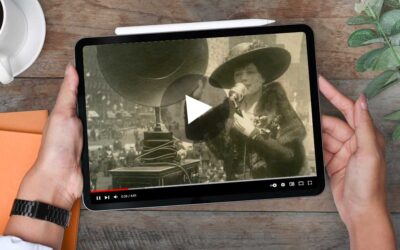The Future of Augmented and Virtual Reality (AR & VR) in Museums

Rachael Cristine Woody
It is undeniable that technology has a growing presence within the museum sphere. At first, audio-visual technology was harnessed by the museum to augment the museum’s exhibits and provide an enhanced user experience. However, with the universality of everyone owning a smartphone, the museum has seen an increasing rate of technology encroachment, and not of their own making.
Despite museums having the reputation of being technophobic or exceptionally slow at evolving, they have an opportunity now to be proactive in the AR and VR realms.
AR Definition provided by TechTarget: “Augmented reality is the integration of digital information with the user’s environment in real time. Unlike virtual reality, which creates a totally artificial environment, augmented reality uses the existing environment and overlays new information on top of it.”
VR Definition provided by Merriam-Webster: “Virtual reality. An artificial environment which is experienced through sensory stimuli (such as sights and sounds) provided by a computer and in which one’s actions partially determine what happens in the environment.”
The rise of AR and VR in museums has reached a significant crescendo. When one Googles “AR & VR in Museums” there are dozens of reports, presentations, TED Talks, and academic papers, many from the last 18 months. The concept of AR and VR in museums even made an appearance at a recent MuseumNext panel: https://www.museumnext.com/insight/how-can-museums-use-virtual-reality/. Museums are beginning to experiment with utilizing AR and VR to enhance the experience within the museum, or to deliver the museum to a virtual user.
The main directive of a museum is to provide an environment where art, science, history, and cultural objects can be displayed. Museum staff create content and curate objects to tell a story. The experience a museum-goer has when witnessing an exhibit is meant to involve the visual (and sometimes aural sense) and leave the person changed as a result of their exposure to the exhibit. The exhibit is designed to immerse the visitor, evoke emotion, inspire new thoughts, and encourage the person to feel present.
Now apply those principles to an AR or VR experience. The senses are used to a much greater extent and immersion has increased exponentially. In fact, creating a VR space mimics many of the core principles museums use to create exhibitions: creating content, curating objects, and building a story centered within the space, to interact with objects. AR is layered on top of what is already physically present in museums as a way to enhance or add to what is already there. The nature of AR and VR naturally lends itself to the museum space and can be used as tools to raise the level of present-ness within an exhibit.
Let’s break it down into some commonly known Pros & Cons:
Pros
- VR is being branded as an empathy machine. Meaning the first-person view VR provides with its fully immersive platform elicits a compassionate response from users. AR and VR both provide a greater ability to place things, events, and people within context—leading to a greater understanding. VR offers a more holistic form of storytelling.
- VR, and to a lesser extent AR, can open up museum exhibits to people unable to attend or fully engage in the physical exhibit experience.
- Whether it’s the lure of technology or the promise of a more immersive museums experience, museums who’ve tested AR and VR technology in their exhibits experienced higher attendance.
Cons
- Museums are concerned that providing a VR experience of their museum to remote users will replace the need for a physical museum. This was a similar concern when museums were confronted with users expecting exhibits and objects to be available online. In a majority of cases online content has only served to increase interest and attendance to a physical museum. It’s not a stretch to believe this will be true for remote VR museum experiences.
- The cost of evolving AR and VR technology is still high, especially given the bespoke nature of a currently unsustainable hardware and software setup. These are still nascent technologies, especially when being considered for exhibit application. However, VIVE Arts (https://arts.vive.com/us/) is one example of how museums can find a resourceful partner to explore (in this case) VR-museum projects.
- The logistics of AR and VR can be daunting. Technology aside, the experience will also require space and controls set up to help keep museum visitors safe. Though the technology is getting increasingly better, users can experience forms of nausea or anxiety, and there’s also hygiene to consider when reusing equipment that is placed on people’s heads. In many of the museum examples, exhibit hosts had to be present to help manage these issues.
Conclusion
The question remains: Are museums ready for the disruptive shift AR and VR promise to present? It’s hard to predict where the evolution of technology (as pertaining to its embedment in museums) will go. But we do know that technology is now actively and irrevocably shaping the future of how museum experiences will be presented and interacted with. Predictions show AR and VR are only 10 years from mainstream adoption. Think about how quickly you became attached to your smartphone. How many years did it take before your smartphone managed or provided access to major parts of your life? The truth is, AR and VR aren’t far behind.

Rachael Cristine Woody
Stan writes regularly for Lucidea’s Think Clearly blog. Subscribe to ensure you never miss a post with engaging information for KM practitioners and special librarians! Learn about Lucidea’s Presto, SydneyDigital, and GeniePlus software with unrivaled KM capabilities that enable successful knowledge curation and sharing.
Similar Posts
Captivating Story Delivery with a Multimedia Player
My recent posts reviewed how museums can use storytelling tools provided by their Collections Management System (CMS)—including zoom tools, slideshows, and flipbooks—as strategic storytelling aids. Each of these tools capitalize on being highly visual and offer...
How to Use Slideshows and Flipbooks to Offer Engaging Museum Story Visuals
Museums thrive on storytelling, and the right digital tools can make all the difference. Slideshows and flipbooks offer an engaging way to showcase collections, drawing visitors in with dynamic visuals and interactive elements.
Zooming Into Story Details:
How Museums Can Enhance Storytelling with Visual Tools
Visual tools such as zoom are crowd pleasers when presenting visual content online, allowing museums to create immersive and engaging digital experiences.
7 Digital Storytelling Elements That Live In Your Museum CMS
A museum’s Collections Management System (CMS) is more than just a catalog—it can also serve as a foundation for digital storytelling. By leveraging the rich object data and images already housed in the CMS, museum professionals can experiment with new ways to craft compelling narratives. In this article, Rachael Cristine Woody explores how different types of digital surrogates can bring museum collections to life online.



